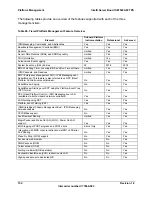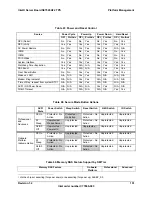
Intel® Server Board SE7520AF2 TPS
Platform Management
Revision 1.2
155
Intel order number C77866-003
sensor access. The message-based interface isolates software from the particular hardware
implementation.
System Management Software discovers the platform’s sensor capabilities by reading the
Sensor Data Records from a Sensor Data Record Repository managed by the management
controller (i.e. mBMC or IMM). Sensor Data Records provide a list of the sensors, their
characteristics, location, type, and associated Sensor Number, for sensors in a particular
system. The Sensor Data Records also hold default threshold values (if the sensor has
threshold based events), factors for converting a sensor reading into the appropriate units (mV,
rpm, degrees Celsius, etc.), and information on the types of events that a sensor can generate.
Sensor Data Records also provide information on where Field Replaceable Unit (FRU)
information is located, and information to link sensors with the entity and/or FRU they’re
associated with.
Information in the SDRs is also used for configuring and restoring sensor thresholds and event
generation whenever the system powers up or is reset. This is accomplished via a process
called the ‘initialization agent’. The management controller reads the SDRs and based on bit
settings, writes the threshold data. Then it enables event generation for the various sensors it
monitors.
System Management Software uses the data contained in the Sensor Data Record information
to locate sensors in order to poll them, interpret, and present their data readings, adjust
thresholds, interpret SEL entries, and alter event generation settings.
In Standard and Advanced management models, SDRs also provide a mechanism for
extending the baseboard management with additional chassis or OEM ‘value-added’ monitoring
and events. The baseboard monitoring can be extended by implementing an IPMI-compatible
management controller, connecting it to the IPMB, and adding new SDRs describing that
controller and its sensors to the SDR Repository. System Management Software can then read
the SDRs and use them to automatically incorporate the additional sensors.
6.1.5
Private Management Bus
A ‘Private Management Bus’ is a single-master I
2
C bus that is controlled by the management
controller. Access to any of the devices on the Private Management Bus is accomplished
indirectly via commands to the management controller via the IPMB or system interfaces. The
Private Management bus is a common mechanism used for accessing temperature sensors,
system processor information, and other baseboard monitoring devices that are located in
various locations in the system.
The devices on the Private Management Bus are isolated from traffic on the IPMB. Since
devices such as temperature sensors are polled by the management controller, this gets the
polling traffic off the ‘public’ IPMB bus. This also increases the reliability of access to the
information, since issues with IPMB bus arbitration and message retries are avoided.
Furthermore, placing managed I
2
C devices on the private management bus frees up the I
2
C
addresses that those devices would have used up on the IPMB.






























